Coburn J.W. Algebra and Trigonometry
Подождите немного. Документ загружается.

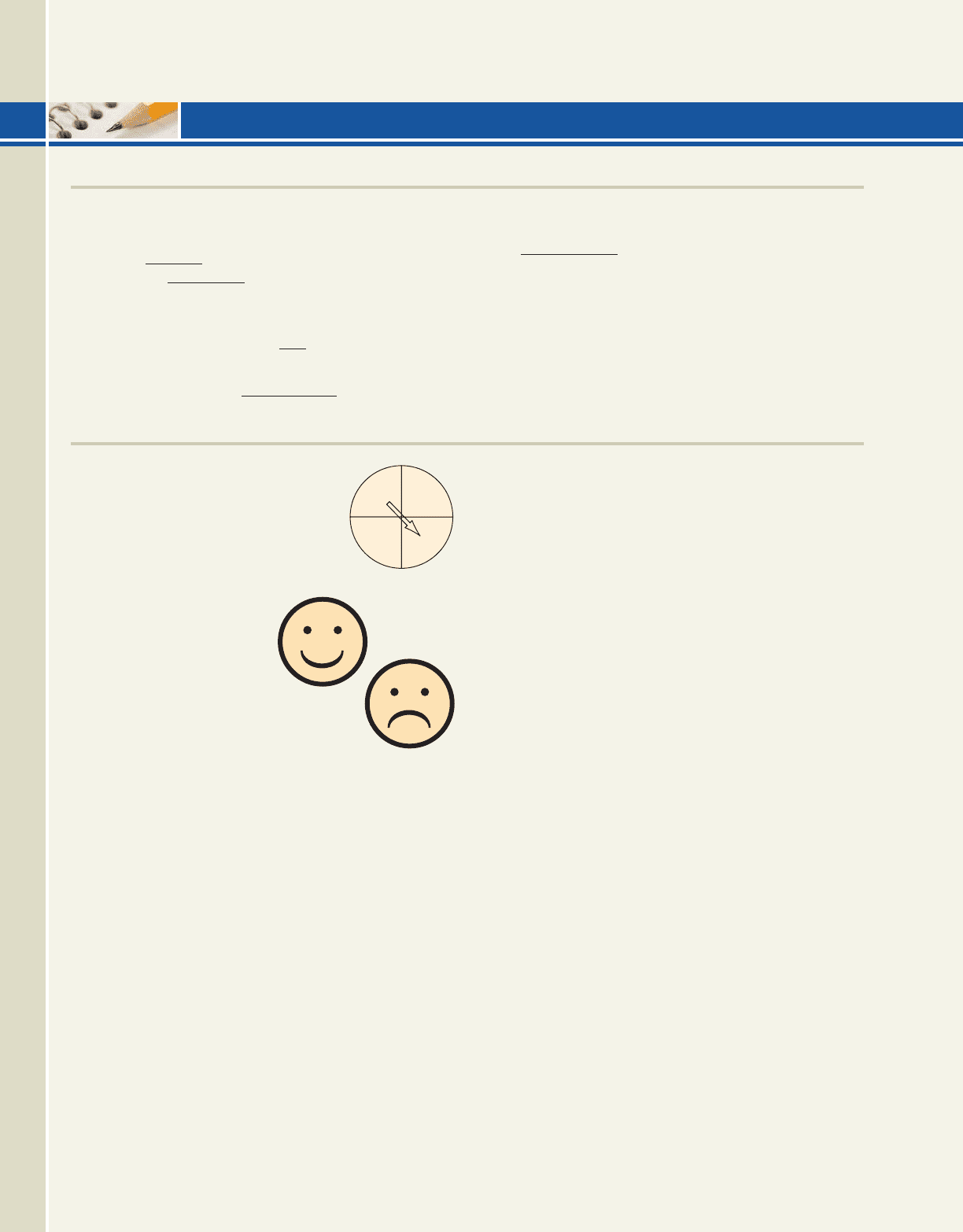
1060 CHAPTER 11 Additional Topics in Algebra 11-44
11.5 EXERCISES
CONCEPTS AND VOCABULARY
Fill in the blank with the appropriate word or phrase.
Carefully reread the section if needed.
1. A(n) is any task that can be repeated and
has a(n) set of possible outcomes.
2. If an experiment has N equally likely outcomes and
is repeated t times, the number of elements in the
sample space is given by .
3. When unique elements of a set are rearranged, the
result is called a(n) permutation.
4. If some elements of a group are identical, certain
rearrangements are identical and the result is a(n)
permutation.
5. A three-digit number is formed from digits 1 to 9.
Explain how forming the number with repetition
differs from forming it without repetition.
6. Discuss/Explain the difference between a
permutation and a combination. Try to think of
new ways to help remember the distinction.
DEVELOPING YOUR SKILLS
7. For the spinner shown here,
(a) draw a tree diagram illustrating
all possible outcomes for two spins
and (b) create an ordered list
showing all possible outcomes for
two spins.
8. For the fair coin shown
here, (a) draw a tree
diagram illustrating all
possible outcomes for
four flips and (b) create
an ordered list showing the
possible outcomes for four flips.
9. A fair coin is flipped five times. If you
extend the tree diagram from Exercise 8,
how many elements are in the sample space?
10. A spinner has the two equally likely outcomes A or
B and is spun four times. How is this experiment
related to the one in Exercise 8? How many
elements are in the sample space?
11. An inexpensive lock uses the numbers 0 to 24 for a
three-number combination. How many different
combinations are possible?
12. Grades at a local college consist of A, B, C, D, F,
and W. If four classes are taken, how many
different report cards are possible?
License plates. In a certain (English-speaking) country,
license plates for automobiles consist of two letters
followed by one of four symbols (■, ◆, ❍, or ●), followed
by three digits. How many license plates are possible if
13. Repetition is allowed?
14. Repetition is not allowed?
15. A remote access door opener requires a five-digit
(1–9) sequence. How many sequences are possible
if (a) repetition is allowed? (b) repetition is not
allowed?
16. An instructor is qualified to teach Math 020, 030,
140, and 160. How many different four-course
schedules are possible if (a) repetition is allowed?
(b) repetition is not allowed?
Use the fundamental principle of counting and other
quick-counting techniques to respond.
17. Menu items: At Joe’s Diner, the manager is
offering a dinner special that consists of one choice
of entree (chicken, beef, soy meat, or pork), two
vegetable servings (corn, carrots, green beans,
peas, broccoli, or okra), and one choice of pasta,
rice, or potatoes. How many different meals are
possible?
18. Getting dressed: A frugal businessman has five
shirts, seven ties, four pairs of dress pants, and
three pairs of dress shoes. Assuming that all
possible arrangements are appealing, how many
different shirt-tie-pants-shoes outfits are possible?
19. Number combinations: How many four-digit
numbers can be formed using the even digits 0, 2,
4, 6, 8, if (a) no repetitions are allowed;
(b) repetitions are allowed; (c) repetitions are
not allowed and the number must be less than 6000
and divisible by 10.
20. Number combinations: If I was born in March,
April, or May, after the 19th but before the 30th,
ZW
YX
Heads
Tails
College Algebra & Trignometry—
cob19529_ch11_1017-1096.qxd 12/8/08 21:51 Page 1060

11-45 Section 11.5 Counting Techniques 1061
and after 1949 but before 1981, how many
different MM–DD–YYYY dates are possible for
my birthday?
Seating arrangements: William, Xayden, York, and Zelda
decide to sit together at the movies. How many ways can
they be seated if
21. They sit in random order?
22. York must sit next to Zelda?
23. York and Zelda must be on the outside?
24. William must have the aisle seat?
Course schedule: A college student is trying to set her
schedule for the next semester and is planning to take five
classes: English, art, math, fitness, and science. How many
different schedules are possible if
25. The classes can be taken in any order.
26. She wants her science class to immediately follow
her math class.
27. She wants her English class to be first and her
fitness class to be last.
28. She can’t decide on the best order and simply takes
the classes in alphabetical order.
Find the value of
n
P
r
in two ways: (a) compute r factors
of n! and (b) use the formula
29.
10
P
3
30.
12
P
2
31.
9
P
4
32.
5
P
3
33.
8
P
7
34.
8
P
1
Determine the number of three-letter permutations of
the letters given, then use an organized list to write them
all out. How many of them are actually words or
common names?
35. T, R, and A 36. P, M, and A
37. The regional manager for an office supply store
needs to replace the manager and assistant manager
at the downtown store. In how many ways can this
be done if she selects the personnel from a group
of 10 qualified applicants?
38. The local chapter of Mu Alpha Theta will soon be
electing a president, vice-president, and treasurer.
In how many ways can the positions be filled if the
chapter has 15 members?
39. The local school board is going to select a
principal, vice-principal, and assistant vice-
principal from a pool of eight qualified candidates.
In how many ways can this be done?
n
P
r
n!
1n r2!
.
40. From a pool of 32 applicants, a board of directors
must select a president, vice-president, labor
relations liaison, and a director of personnel for the
company’s day-to-day operations. Assuming all
applicants are qualified and willing to take on any of
these positions, how many ways can this be done?
41. A hugely popular chess tournament now has six
finalists. Assuming there are no ties, (a) in how
many ways can the finalists place in the final
round? (b) In how many ways can they finish first,
second, and third? (c) In how many ways can they
finish if it’s sure that Roberta Fischer is going to
win the tournament and that Geraldine Kasparov
will come in sixth?
42. A field of 10 horses has just left the paddock area
and is heading for the gate. Assuming there are no
ties in the big race, (a) in how many ways can the
horses place in the race? (b) In how many ways can
they finish in the win, place, or show positions? (c)
In how many ways can they finish if it’s sure that
John Henry III is going to win, Seattle Slew III will
come in second (place), and either Dumb Luck II
or Calamity Jane I will come in tenth?
Assuming all multiple births are identical and the
children cannot be told apart, how many distinguishable
photographs can be taken of a family of six, if they
stand in a single row and there is
43. one set of twins
44. one set of triplets
45. one set of twins and one set of triplets
46. one set of quadruplets
47. How many distinguishable numbers can be made
by rearranging the digits of 105,001?
48. How many distinguishable numbers can be made by
rearranging the digits in the palindrome 1,234,321?
How many distinguishable permutations can be formed
from the letters of the given word?
49. logic 50. leave
51. lotto 52. levee
A Scrabble player (see Example 7) has the six letters
shown remaining in her rack. How many
distinguishable, six-letter permutations can be formed?
(If all six letters are played, what was the word?)
53. A, A, A, N, N, B
54. D, D, D, N, A, E
College Algebra & Trignometry—
cob19529_ch11_1017-1096.qxd 12/8/08 21:51 Page 1061

1062 CHAPTER 11 Additional Topics in Algebra 11-46
Find the value of
n
C
r
: (a) using (r factors of n!
over r!) and (b) using
55.
9
C
4
56.
10
C
3
57.
8
C
5
58.
6
C
3
59.
6
C
6
60.
6
C
0
Use a calculator to verify that each pair of combinations
is equal.
61.
9
C
4
,
9
C
5
62.
10
C
3
,
10
C
7
63.
8
C
5
,
8
C
3
64.
7
C
2
,
7
C
5
65. A platoon leader needs to send four soldiers to do
some reconnaissance work. There are 12 soldiers in
the platoon and each soldier is assigned a number
between 1 and 12. The numbers 1 through 12 are
placed in a helmet and drawn randomly. If a
soldier’s number is drawn, then that soldier goes on
the mission. In how many ways can the
reconnaissance team be chosen?
66. Seven colored balls (red, indigo, violet, yellow,
green, blue, and orange) are placed in a bag and
three are then withdrawn. In how many ways can
the three colored balls be drawn?
67. When the company’s switchboard operators went
on strike, the company president asked for three
volunteers from among the managerial ranks to
temporarily take their place. In how many ways
can the three volunteers “step forward,” if there are
14 managers and assistant managers in all?
68. Becky has identified 12 books she wants to read this
year and decides to take four with her to read while
on vacation. She chooses Pastwatch by Orson Scott
Card for sure, then decides to randomly choose any
three of the remaining books. In how many ways
can she select the four books she’ll end up taking?
69. A new garage band has built up their repertoire to 10
excellent songs that really rock. Next month they’ll
be playing in a Battle of the Bands contest, with the
n
C
r
n!
r!1n r2!
.
n
C
r
n
P
r
r!
winner getting some guaranteed gigs at the city’s
most popular hot spots. In how many ways can the
band select 5 of their 10 songs to play at the contest?
70. Pierre de Guirré is an award-winning chef and has
just developed 12 delectable, new main-course
recipes for his restaurant. In how many ways can
he select three of the recipes to be entered in an
international culinary competition?
For each exercise, determine whether a permutation, a
combination, counting principles, or a determination of
the number of subsets is the most appropriate tool for
obtaining a solution, then solve. Some exercises can be
completed using more than one method.
71. In how many ways can eight second-grade children
line up for lunch?
72. If you flip a fair coin five times, how many
different outcomes are possible?
73. Eight sprinters are competing for the gold, silver,
and bronze medals. In how many ways can the
medals be awarded?
74. Motorcycle license plates are made using two letters
followed by three numbers. How many plates can be
made if repetition of letters (only) is allowed?
75. A committee of five students is chosen from a class
of 20 to attend a seminar. How many different
ways can this be done?
76. If onions, cheese, pickles, and tomatoes are
available to dress a hamburger, how many different
hamburgers can be made?
77. A caterer offers eight kinds of fruit to make various
fruit trays. How many different trays can be made
using four different fruits?
78. Eighteen females try out for the basketball team,
but the coach can only place 15 on her roster. How
many different teams can be formed?
WORKING WITH FORMULAS
79. Stirling’s Formula:
Values of n! grow very quickly as n gets larger
(13! is already in the billions). For some applications,
scientists find it useful to use the approximation for
n! shown, called Stirling’s Formula.
a. Compute the value of 7! on your calculator,
then use Stirling’s Formula with By
what percent does the approximate value differ
from the true value?
b. Compute the value of 10! on your calculator,
then use Stirling’s Formula with Byn 10.
n 7.
n! 12
#
1n
n0.5
2
#
e
n
what percent does the approximate value differ
from the true value?
80. Factorial formulas: For , where
a. Verify the formula for and
b. Verify the formula for and k 6.n 9
k 5.n 7
n!
1n k2!
n1n 121n 22
p
1n k 12
n 7 k,
n, k
College Algebra & Trignometry—
cob19529_ch11_1017-1096.qxd 12/8/08 21:51 Page 1062
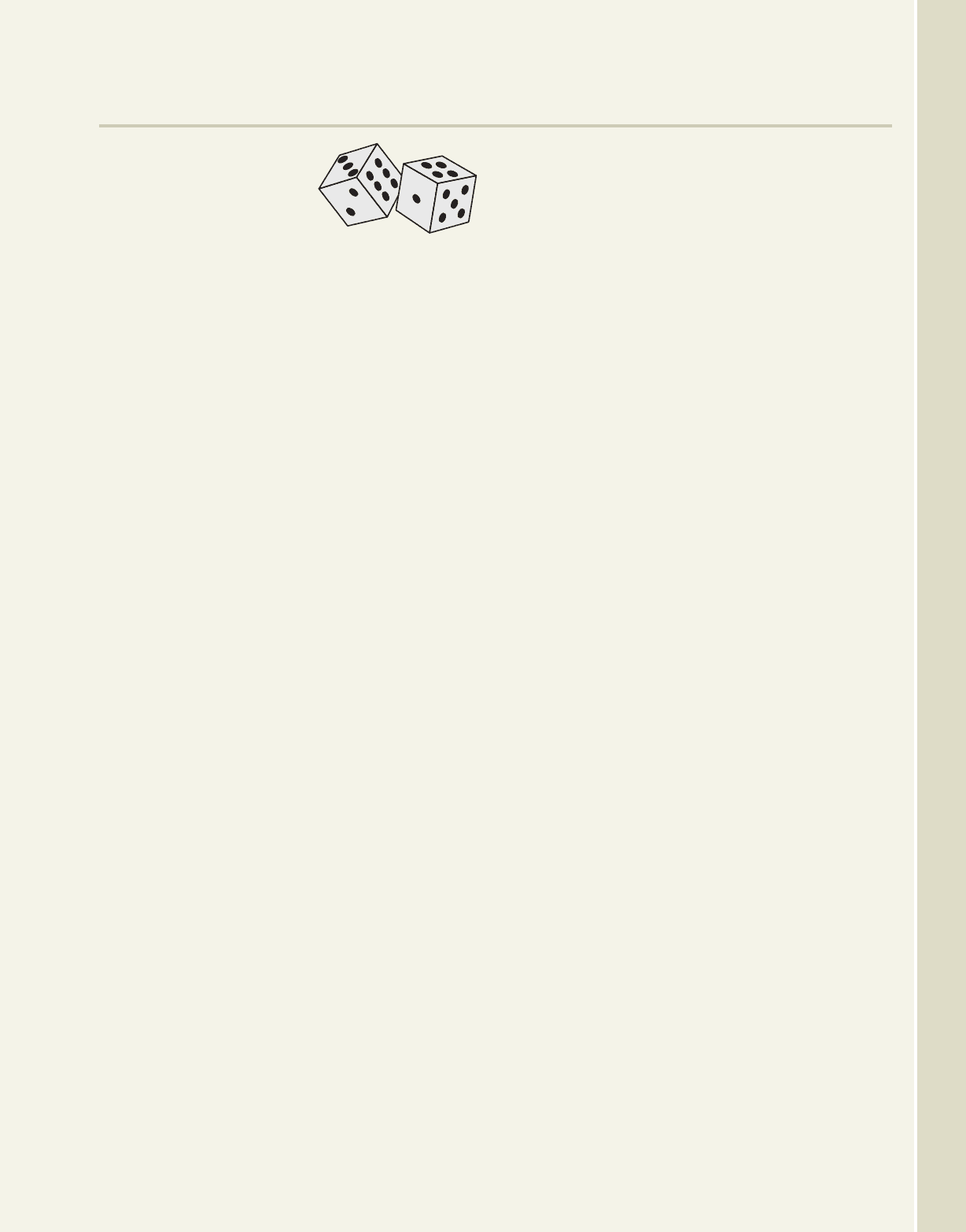
11-47 Section 11.5 Counting Techniques 1063
81. Yahtzee: In the game of
“Yahtzee”
®
(Milton
Bradley) five dice are
rolled simultaneously on
the first turn in an
attempt to obtain various
arrangements (worth various point values). How
many different arrangements are possible?
82. Twister: In the game of “Twister”
®
(Milton
Bradley) a simple spinner is divided into four
quadrants designated Left Foot (LF), Right Hand
(RH), Right Foot (RF), and Left Hand (LH), with
four different color possibilities in each quadrant
(red, green, yellow, blue). Determine the number
of possible outcomes for three spins.
83. Clue: In the game of “Clue”
®
(Parker Brothers) a
crime is committed in one of nine rooms, with one
of six implements, by one of six people. In how
many different ways can the crime be committed?
Phone numbers in North America have 10 digits: a three-
digit area code, a three-digit exchange number, and the four
final digits that make each phone number unique. Neither
area codes nor exchange numbers can start with 0 or 1. Prior
to 1994 the second digit of the area code had to be a 0 or 1.
Sixteen area codes are reserved for special services (such as
911 and 411). In 1994, the last area code was used up and the
rules were changed to allow the digits 2 through 9 as the
middle digit in area codes.
84. How many different area codes were possible
prior to 1994?
85. How many different exchange numbers were
possible prior to 1994?
86. How many different phone numbers were possible
prior to 1994?
87. How many different phone numbers were possible
after 1994?
Aircraft N-numbers: In the United States, private aircraft
are identified by an “N-Number,” which is generally the
letter “N” followed by five characters and includes these
restrictions: (1) the N-Number can consist of five digits,
four digits followed by one letter, or three digits followed
by two letters; (2) the first digit cannot be a zero; (3) to
avoid confusion with the numbers zero and one, the letters
O and I cannot be used; and (4) repetition of digits and
letters is allowed. How many unique N-Numbers can be
formed
88. that have four digits and one letter?
89. that have three digits and two letters?
90. that have five digits?
91. that have three digits, two letters with no
repetitions of any kind allowed?
Seating arrangements: Eight people would like to be
seated. Assuming some will have to stand, in how many
ways can the seats be filled if the number of seats
available is
92. eight 93. five
94. three 95. one
Seating arrangements: In how many different ways can
eight people (six students and two teachers) sit in a row of
eight seats if
96. the teachers must sit on the ends
97. the teachers must sit together
Television station programming: A television station
needs to fill eight half-hour slots for its Tuesday evening
schedule with eight programs. In how many ways can this
be done if
98. there are no constraints
99. Seinfeld must have the 8:00
P.M. slot
100. Seinfeld must have the 8:00
P.M. slot and The Drew
Carey Show must be shown at 6:00
P.M.
101. Friends can be aired at 7:00 or 9:00
P.M. and
Everybody Loves Raymond can be aired at 6:00 or
8:00
P.M.
Scholarship awards: Fifteen students at Roosevelt
Community College have applied for six available
scholarship awards. How many ways can the awards be
given if
102. there are six different awards given to six different
students
103. there are six identical awards given to six different
students
Committee composition: The local city council has 10
members and is trying to decide if they want to be governed
by a committee of three people or by a president, vice-
president, and secretary.
104. If they are to be governed by committee, how many
unique committees can be formed?
105. How many different president, vice-president, and
secretary possibilities are there?
APPLICATIONS
College Algebra & Trignometry—
cob19529_ch11_1017-1096.qxd 12/8/08 21:51 Page 1063
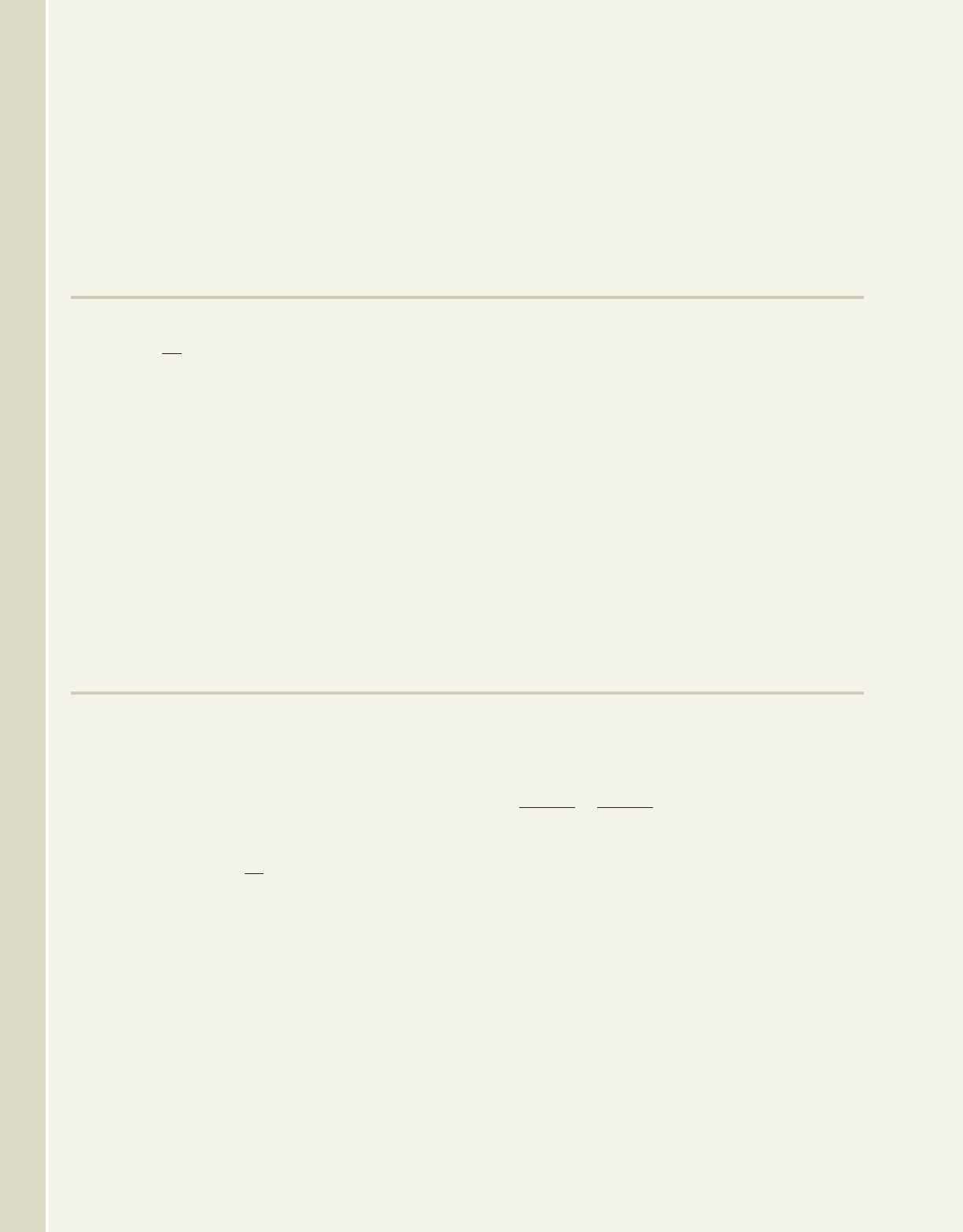
1064 CHAPTER 11 Additional Topics in Algebra 11-48
106. Team rosters:A soccer team has three goalies,
eight defensive players, and eight forwards on its
roster. How many different starting line-ups can be
formed (one goalie, three defensive players, and
three forwards)?
107. e-mail addresses: A business wants to
standardize the e-mail addresses of its
employees. To make them easier to remember
and use, they consist of two letters and two digits
(followed by @esmtb.com), with zero being
excluded from use as the first digit and no
repetition of letters or digits allowed. Will this
provide enough unique addresses for their 53,000
employees worldwide?
EXTENDING THE CONCEPT
108. In Exercise 79, we learned that an approximation
for n! can be found using Stirling’s Formula:
As with other
approximations, mathematicians are very interested
in whether the approximation gets better or worse
for larger values of n (does their ratio get closer to
1 or farther from 1). Use your calculator to
investigate and answer the question.
109. Verify that the following equations are true, then
generalize the patterns and relationships noted to
create your own equation. Afterward, write each of
the four factors from Part (a) (the two
combinations on each side) in expanded form and
discuss/explain why the two sides are equal.
a.
b.
9
C
3
#
6
C
2
9
C
2
#
7
C
4
10
C
3
#
7
C
2
10
C
2
#
8
C
5
n! 121n
n0.5
2e
n
.
c.
d.
110. Tic-Tac-Toe: In the game Tic-Tac-Toe, players
alternately write an “X” or an “O” in one of nine
squares on a grid. If either player gets three
in a row horizontally, vertically, or diagonally, that
player wins. If all nine squares are played with
neither person winning, the game is a draw.
Assuming “X” always goes first,
a. How many different “boards” are possible if
the game ends after five plays?
b. How many different “boards” are possible if
the game ends after six plays?
3 3
8
C
3
#
5
C
2
8
C
2
#
6
C
3
11
C
4
#
7
C
5
11
C
5
#
6
C
4
MAINTAINING YOUR SKILLS
111. (5.4) Solve the given system of linear inequalities
by graphing. Shade the feasible region.
112. (5.2) Given , determine the other five
trig functions of the acute angle .
sin
12
13
μ
2x y 6 6
x 2y 6 6
x 0
y 0
113. (6.3) Rewrite as
a single expression.
114. (7.3) Graph the hyperbola that is defined by
.
1x 22
2
4
1y 32
2
9
1
cos122cos132 sin122sin132
College Algebra & Trignometry—
cob19529_ch11_1017-1096.qxd 01/15/2009 01:34 am Page 1064
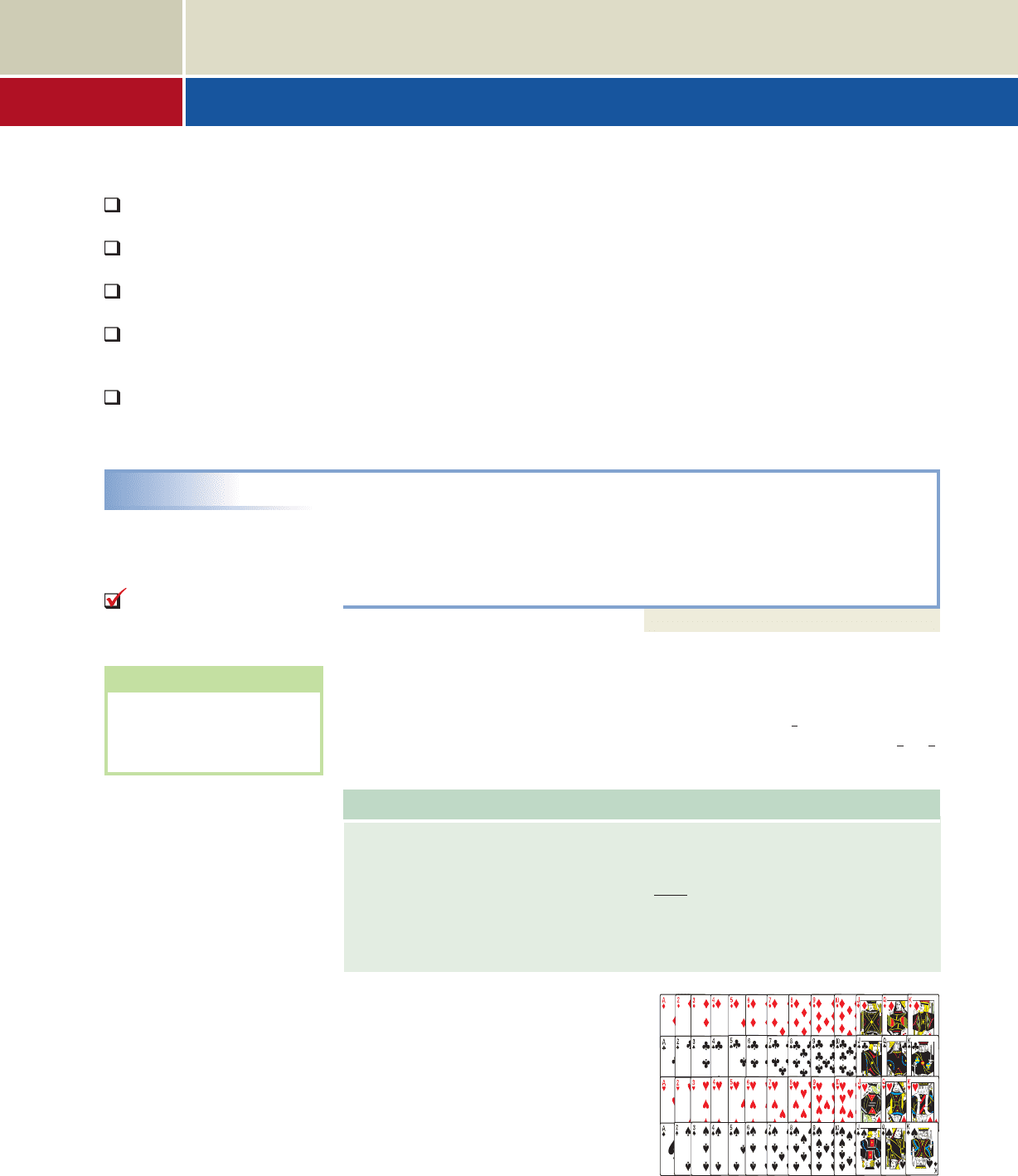
11.6 Introduction to Probability
There are few areas of mathematics that give us a better view of the world than
probabilityand statistics. Unlike statistics, which seeks to analyze and interpret data,
probability (for our purposes) attempts to use observations and data to make statements
concerning the likelihood of future events. Such predictions of what mighthappen have
found widespread application in such diverse fields as politics, manufacturing, gam-
bling, opinion polls, product life, and many others. In this section, we develop the basic
elements of probability.
A. Defining an Event
In Section 11.5 we defined the following terms: experiment and sample outcome. Flip-
ping a coin twice in succession is an experiment, and two sample outcomes are HH
and HT. An event E is any designated set of sample outcomes, and is a subset of the
sample space. One event might be E
1
: (two heads occur), another possibility is E
2
: (at
least one tail occurs).
EXAMPLE 1
Stating a Sample Space and Defining an Event
Consider the experiment of rolling one standard, six-sided die (plural is dice). State
the sample space S and define any two events relative to S.
Solution
S is the set of all possible outcomes, so Two possible events
are E
1
: (a 5 is rolled) and E
2
: (an even number is rolled).
Now try Exercises 7 through 10
B. Elementary Probability
When rolling the die, we know the result can be any of the six equally likely outcomes
in the sample space, so the chance of E
1
:(a five is rolled) is Since three of the
elements in S are even numbers, the chance of E
2
:(an even number is rolled) is
This suggests the following definition.
The Probability of an Event E
Given S is a sample space of equally likely events and E is an event relative to S, the
probability of E, written P(E), is computed as
where n(E) represents the number of elements in E,
and n(S) represents the number of elements in S.
A standard deck of playing cards con-
sists of 52 cards divided in four groups or
suits.There are 13 hearts ( ), 13 diamonds
13 spades ( ), and 13 clubs ( ). As
you can see in the illustration, each of the
13 cards in a suit is labeled 2, 3, 4, 5, 6, 7,
8, 9, 10, J, Q, K, and A. Also notice that 26
of the cards are red (hearts and diamonds),
26 are black (spades and clubs) and 12 of
the cards are “face cards” (J, Q, K of each
suit).
♣♠12,
♥
P1E2
n1E2
n1S2
3
6
1
2
.
1
6
.
S 51, 2, 3, 4, 5, 66.
Learning Objectives
In Section 11.6 you will learn how to:
A. Define an event on a
sample space
B. Compute elementary
probabilities
C. Use certain properties of
probability
D. Compute probabilities
using quick-counting
techniques
E. Compute probabilities
involving nonexclusive
events
WORTHY OF NOTE
Our study of probability will
involve only those sample
spaces with events that are
equally likely.
11-49 1065
A. You’ve just learned how
to define an event on a
sample space
College Algebra & Trignometry—
cob19529_ch11_1017-1096.qxd 12/8/08 21:53 Page 1065
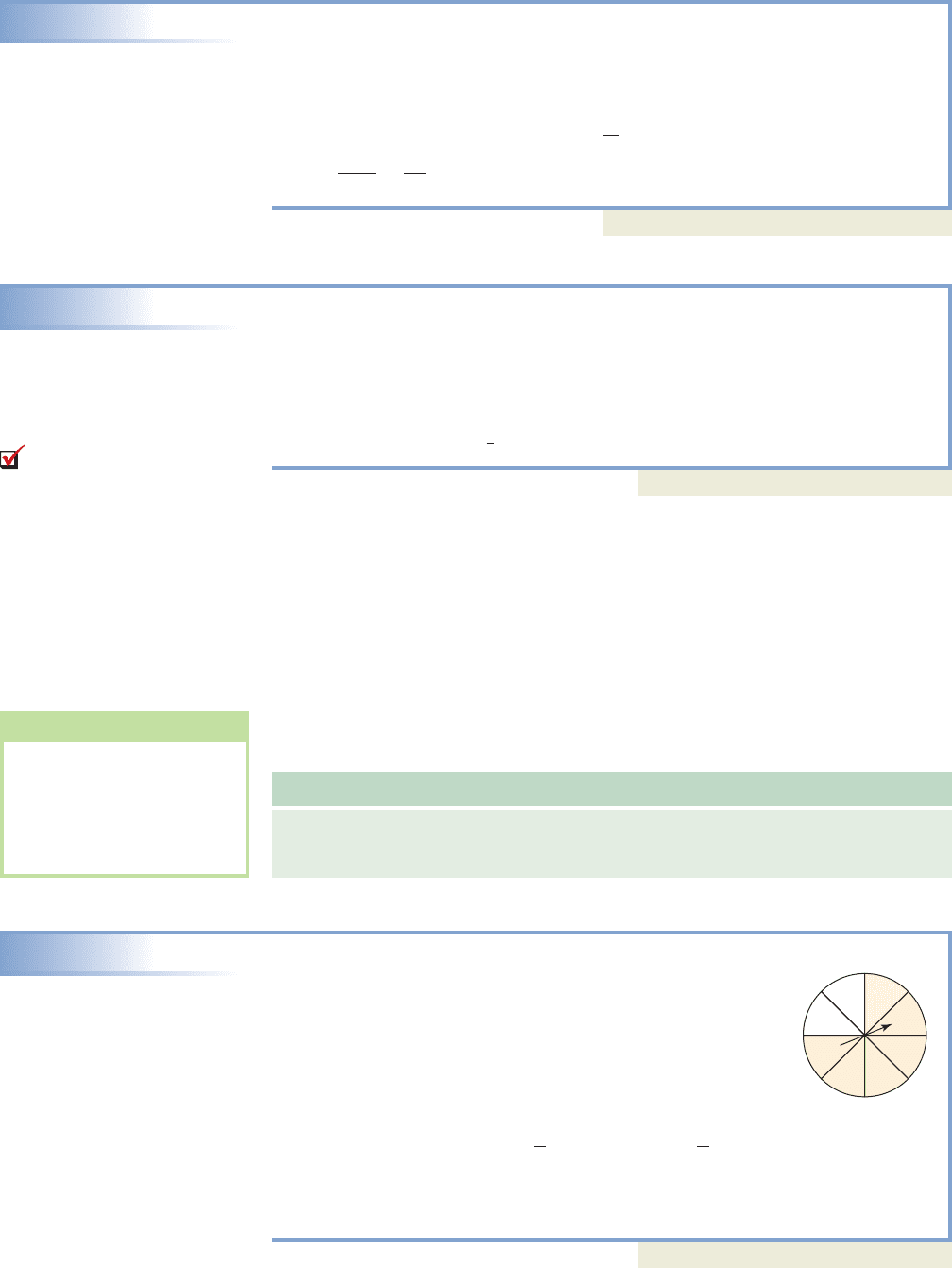
1066 CHAPTER 11 Additional Topics in Algebra 11-50
EXAMPLE 2
Stating a Sample Space and the Probability of a Single Outcome
A single card is drawn from a well-shuffled deck. Define S and state the probability
of any single outcome. Then define E as a King is drawn and find P(E).
Solution
Sample space: . There are 52 equally likely outcomes,
so the probability of any one outcome is Since S has four Kings,
or about 0.077.
Now try Exercises 11 through 14
EXAMPLE 3
Stating a Sample Space and the Probability of a Single Outcome
A family of five has two girls and three boys named Sophie, Maria, Albert, Isaac,
and Pythagoras. Their ages are 21, 19, 15, 13, and 9, respectively. One is to be
selected randomly. Find the probability a teenager is chosen.
Solution
The sample space is Three of the five are teenagers,
meaning the probability is or 60%.
Now try Exercises 15 and 16
C. Properties of Probability
A study of probability necessarily includes recognizing some basic and fundamental
properties. For example, when a fair die is rolled, what is P(E) if E is defined as a 1,
2, 3, 4, 5, or 6 is rolled? The event E will occur 100% of the time, since 1, 2, 3, 4, 5, 6
are the only possibilities. In symbols we write P(outcome is in the sample space) or
simply (100%).
What percent of the time will a result not in the sample space occur? Since the die
has only the six sides numbered 1 through 6, the probability of rolling something else
is zero. In symbols, or simply
Properties of Probability
Given sample space S and any event E defined relative to S.
1. 2. 3.
EXAMPLE 4
Determining the Probability of an Event
A game is played using a spinner like the one shown.
Determine the probability of the following events:
E
1
: A nine is spun. E
2
: An integer greater than 0 and less
than 9 is spun.
Solution
The sample space consists of eight equally likely outcomes.
Technically, E
1
: A nine is spun is not an “event,” since it is not in the sample space
and cannot occur, while E
2
contains the entire sample space and must occur.
Now try Exercises 17 and 18
P1E
1
2
0
8
0
P1E
2
2
8
8
1.
0 P1E2 1P1~S2 0P1S2 1
P1~S2 0.P1outcome is not in sample space2 0
P1S2 1
3
5
, 0.6,
S 59, 13, 15, 19, 216.
P1E2
n1E2
n1S2
4
52
1
52
.
S 5the 52 cards6
B. You’ve just learned how
to compute elementary
probabilities
WORTHY OF NOTE
In probability studies, the
tilde “~” acts as a negation
symbol. For any event E
defined on the sample space,
~E means the event does not
occur.
1
23
4
5
6
7
8
College Algebra & Trignometry—
cob19529_ch11_1017-1096.qxd 12/8/08 21:53 Page 1066
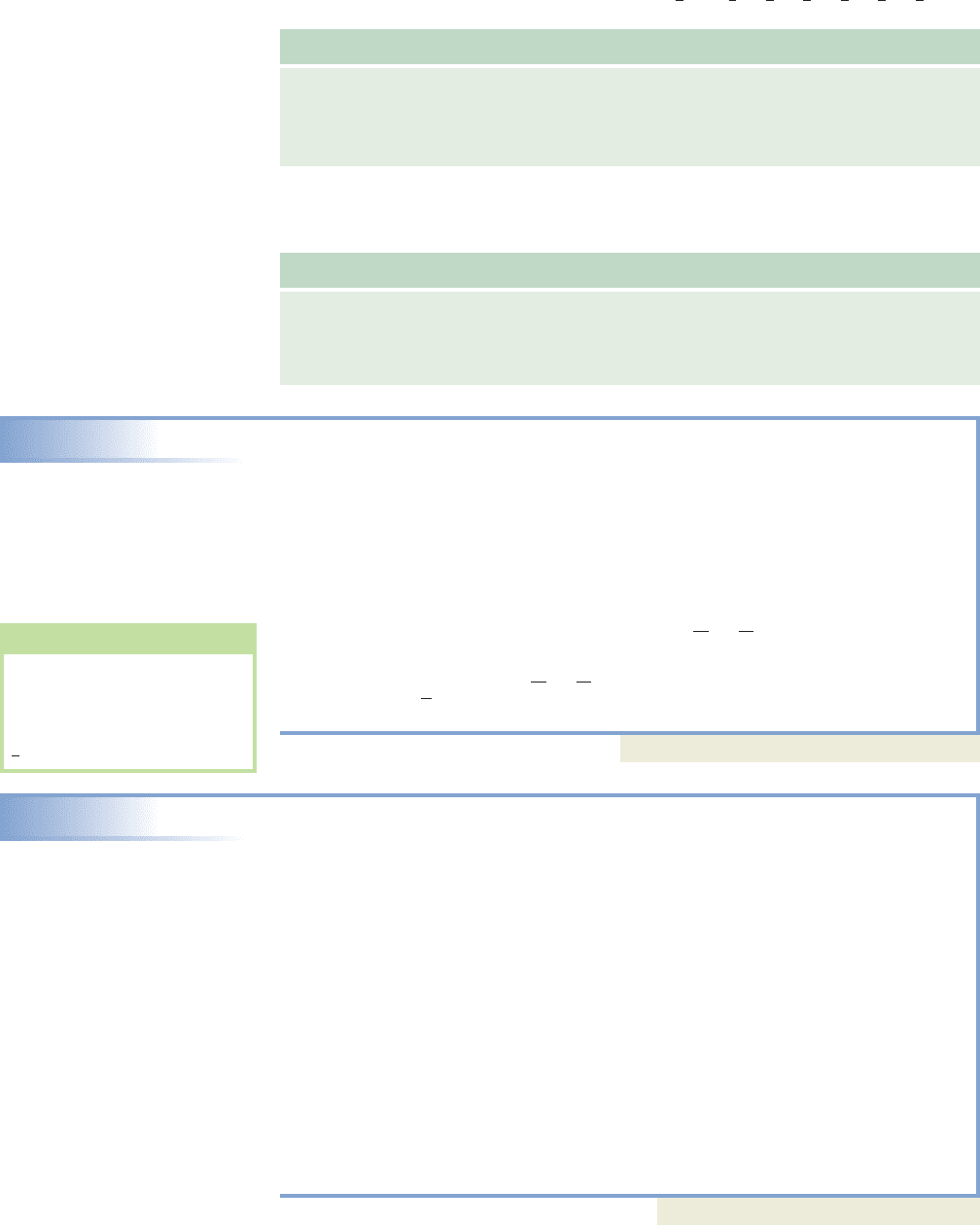
11-51 Section 11.6 Introduction to Probability 1067
Because we know and all sample outcomes are equally likely, the probabil-
ities of all single events defined on the sample space must sum to 1. For the experiment of
rolling a fair die, the sample space has six outcomes that are equally likely. Note that
and
Probability and Sample Outcomes
Given a sample space S with n equally likely sample outcomes s
1
, s
2
, s
3
, . . . , s
n
.
The complement of an event E is the set of sample outcomes in S not contained
in E. Symbolically, is the complement of E.
Probability and Complementary Events
Given sample space S and any event E defined relative to S, the complement of E,
written is the set of all outcomes not in E and:
1. 2.
EXAMPLE 5
Stating a Probability Using Complements
Use complementary events to answer the following questions:
a. A single card is drawn from a well-shuffled deck. What is the probability that
it is not a diamond?
b. A single letter is picked at random from the letters in the word “divisibility.”
What is the probability it is not an “i”?
Solution
a. Since there are 13 diamonds in a standard 52-card deck, there are
39 nondiamonds:
b. Of the 12 letters in d-i-v-i-s-i-b-i-l-i-t-y, 5 are “i’s.” This means
or The probability of choosing a letter other
than i is
Now try Exercises 19 through 22
EXAMPLE 6
Stating a Probability Using Complements
Inter-Island Waterways has just opened hydrofoil service between several islands.
The hydrofoil is powered by two engines, one forward and one aft, and will operate
if either of its two engines is functioning. Due to testing and past experience, the
company knows the probability of the aft engine failing is
the probability of the forward engine failing is and
the probability that both fail is What
is the probability the hydrofoil completes its next trip?
Solution
Although the answer may seem complicated, note that P(trip is completed) and
P(both engines simultaneously fail) are complements.
There is close to a 99% probability the trip will be completed.
Now try Exercises 23 and 24
0.988
1 0.012
P1trip is completed2 1 P1both engines simultaneously fail2
P1both engines simultaneously fail2 0.012.
P1forward engine fails2 0.03,
P1aft engine fails2 0.05,
0.583
.
1
5
12
7
12
.P1~i2 1 P1i2,
P1~D2 1 P1D2 1
13
52
39
52
0.75.
P1E2 P1~E2 1P1E2 1 P1~E2
~E,
~E
n
i1
P1s
i
2 P1s
1
2 P1s
2
2 P1s
3
2
###
P1s
n
2 1
1
6
1
6
1
6
1
6
1
6
1
6
1.P112 P122 P132 P142 P152 P162
1
6
,
P1S2 1
WORTHY OF NOTE
Probabilities can be written in
fraction form, decimal form,
or as a percent. For P(E
2
) from
Example 1, the probability is
0.75, or 75%.
3
4
,
College Algebra & Trignometry—
cob19529_ch11_1017-1096.qxd 12/8/08 21:53 Page 1067

The chart in Figure 11.16 shows all 36 possible outcomes (the sample space) from
the experiment of rolling two fair dice.
EXAMPLE 7
Stating a Probability Using Complements
Two fair dice are rolled. What is the probability the sum of both dice is greater than
or equal to 5,
Solution
See Figure 11.16. For it may be easier to use complements as there are
far fewer possibilities: which gives
Now try Exercises 25 and 26
D. Probability and Quick-Counting
Quick-counting techniques were introduced earlier to help count the number of ele-
ments in a large or more complex sample space, and the number of sample outcomes
in an event.
EXAMPLE 8A
Stating a Probability Using Combinations
Five cards are drawn from a shuffled 52-card deck. Calculate the probability of
E
1
:(all five cards are face cards) or E
2
:(all five cards are hearts)?
Solution
The sample space for both events consists of all five-card groups that can be
formed from the 52 cards or
52
C
5
. For E
1
we are to select five face cards from the
12 that are available (three from each suit), or
12
C
5
. The probability of five face
cards is which gives For E
2
we are to select five
hearts from the 13 available, or
13
C
5
. The probability of five hearts is
which is
EXAMPLE 8B
Stating a Probability Using Combinations and the Fundamental
Principle of Counting
Of the 42 seniors at Jacoby High School, 23 are female and 19 are male. A group
of five students is to be selected at random to attend a conference in Reno, Nevada.
What is the probability the group will have exactly three females?
1287
2,598,960
0.0005.
n1E2
n1S2
13
C
5
52
C
5
,
792
2,598,960
0.0003.
n1E2
n1S2
12
C
5
52
C
5
,
1
6
36
1
1
6
5
6
0.83.
P1sum 52 1 P1sum 6 52,
P1sum 52
P1sum 52?
1068 CHAPTER 11 Additional Topics in Algebra 11-52
C. You’ve just learned how
to use certain properties of
probability
Figure 11.16
WORTHY OF NOTE
It seems reasonable that the
probability of 5 hearts is
slightly higher, as 13 of the
52 cards are hearts, while
only 12 are face cards.
College Algebra & Trignometry—
cob19529_ch11_1017-1096.qxd 12/8/08 21:53 Page 1068
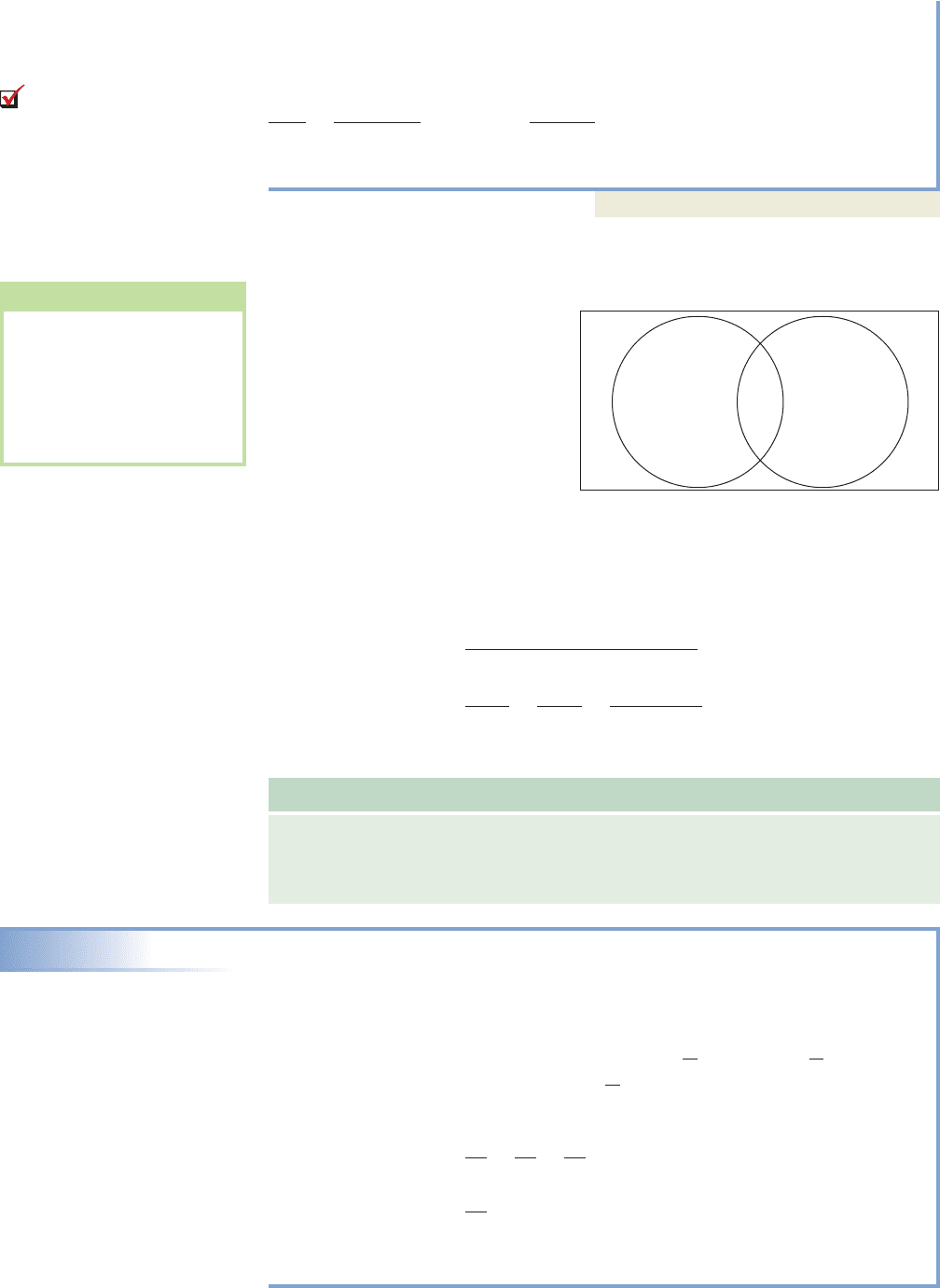
11-53 Section 11.6 Introduction to Probability 1069
Solution
The sample space consists of all five-person groups that can be formed from the
42 seniors or
42
C
5
. The event consists of selecting 3 females from the 23 available
(
23
C
3
) and 2 males from the 19 available (
19
C
2
). Using the fundamental principle of
counting and the probability the group has 3 females is
which gives There is approximately a
35.6% probability the group will have exactly 3 females.
Now try Exercises 27 through 34
E. Probability and Nonexclusive Events
Sometimes the way events are defined
causes them to share sample out-
comes. Using a standard deck of
playing cards once again, if we define
the events E
1
:(a club is drawn) and
E
2
:(a face card is drawn), they share
the outcomes , , and as
shown in Figure 11.17. This overlap-
ping region is the intersection of the
events, or If we compute
as as before, this intersecting region gets counted twice!
In cases where the events are nonexclusive (not mutually exclusive), we main-
tain the correct count by subtracting one of the two intersections, obtaining
This leads to the following calculation
for the probability of nonexclusive events:
definition of probability
property of rational expressions
definition of probability
Probability and Nonexclusive Events
Given sample space S and nonexclusive events E
1
and E
2
defined relative to S, the
probability of E
1
or E
2
is given by
EXAMPLE 9A
Stating the Probability of Nonexclusive Events
What is the probability that a club or a face card is drawn from a standard deck of
52 well-shuffled cards?
Solution
As before, define the events E
1
:(a club is drawn) and E
2
:(a face card is drawn).
Since there are 13 clubs and 12 face cards, and But three of
the face cards are clubs, so This leads to
nonexclusive events
substitute
combine terms
There is about a 42% probability that a club or face card is drawn.
22
52
0.423
13
52
12
52
3
52
P1E
1
´ E
2
2 P1E
1
2 P1E
2
2 P1E
1
E
2
2
P1E
1
E
2
2
3
52
.
P1E
2
2
12
52
.P1E
1
2
13
52
P1E
1
´ E
2
2 P1E
1
2 P1E
2
2 P1E
1
E
2
2
P1E
1
2 P1E
2
2 P1E
1
E
2
2
n1E
1
2
n1S2
n1E
1
2
n1S2
n1E
1
E
2
2
n1S2
P1E
1
´ E
2
2
n1E
1
2 n1E
2
2 n1E
1
E
2
2
n1S2
n1E
1
´ E
2
2 n1E
1
2 n1E
2
2 n1E
1
E
2
2.
n1E
1
2 n1E
2
2n1E
1
´ E
2
2
E
1
E
2
.
K♣Q♣J♣
302,841
850,668
0.356.
n1E2
n1S2
23
C
3
#
19
C
2
42
C
5
,
n1E2
23
C
3
#
19
C
2
D. You’ve just learned how
to compute probabilities
using quick-counting
techniques
WORTHY OF NOTE
This can be verified by simply
counting the elements involved:
and
so
However, there are only 22
possibilities—the , ,
and got counted twice.K♣
Q♣J♣
n1E
1
2 n1E
2
2 25.
n1E
2
2 12n1E
1
2 13
J
♠
Q
♠
K
♠
J♦
Q♦
K♦
J
♥
Q
♥
K
♥
J
♣
Q
♣
K
♣
A
♣
2
♣
3
♣
4
♣
8
♣
9
♣
10
♣
5
♣
6
♣
7
♣
E
1
E
2
S
Figure 11.17
College Algebra & Trignometry—
cob19529_ch11_1017-1096.qxd 12/8/08 21:54 Page 1069
